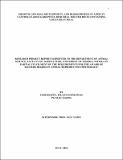UNNSpace Repository
Growth, Gonadal Development, And Blood Profile In African Catfish (Clarias Gariepinus, Burchell 1822) Fed Diets Containing Cocoa Bean Meal
JavaScript is disabled for your browser. Some features of this site may not work without it.
Growth, Gonadal Development, And Blood Profile In African Catfish (Clarias Gariepinus, Burchell 1822) Fed Diets Containing Cocoa Bean Meal
Uzochukwu, Ifeanyi Emmanuel
Date:
2017-03-30
Abstract:
A 63 day experiment was conducted to determine the effect of varying dietary levels of cocoa bean meal (CBM) on the body growth, gonadal development, and blood lipid profile of Clarias gariepinus catfish. Four hundred C. gariepinus post-fingerlings were randomly assigned to five treatments with eighty fish per treatment. Each treatment was replicated four times with 20 fish per replicate in a randomized completely block design (RCBD) with sex as a block. Diets (35% crude protein) containing 0, 10, 20, 40, and 50% CBM were formulated to be fed to the fish in treatments 1, 2, 3, 4, and 5 respectively. Before the commencement of feeding the experimental diet, ten fish (five males and five females) were randomly collected from the various treatments, weighed, dissected, and the gonads (ovaries and testes) harvested and fixed in a bouins fluid. The fixed samples were them taken to the laboratory for histologic and histomorphometric studies. After three weeks of feeding the experimental diets, eight fish (four males and four females) were randomly selected from the various treatments. The gonads were also harvested and fixed for laboratory studies. Further random selections of the fish for laboratory studies were done on fortnightly basis till the 9th week of the study. At the end of the study, four fish from each treatment were selected and blood samples were collected from them for haematology and blood lipid profile. Body weights and lengths measurements were made and recorded on weekly basis. Feed was given to the fish at 5% bio mass and the water changed weekly to ensure freshness. Results of the study showed that the average final standard length, average standard length gain, average final total length, and total length gain were not significantly (P≥0.05) different among the treatments. The average total weight and total weight gain however differed significantly (P<0.05) among the treatments.T2 (10% CBM) had the highest average weight gain value (8.44g). T1 (control) had value (3.59g) which was significantly (P<0.05) lower than T2. T5 (50% CBM) has the lowest value (0.98g) which was also significantly (P<0.05) lower than T2 and the control. T3 and T4 had values (5.55, and 3.59g respectively) which did not differ significantly (P≥0.05) from those of T2 and the control. Also, ovarian weight, testicular weight and GSI values were shown to be significantly (P<0.05) different among the treatment groups. T2 females had the highest ovarian weight and GSI values (2.356g and 6.22) which significantly (P<0.05) different from T3 (0.58g and 1.65 respectively), T1 (0.358g and 1.124 respectively), and T5 (0.36g and 1.21 respectively) which had the least values. T4 had values (1.27g and 3.95 respectively) which did not differ significantly (P≥0.05) from the other groups. Similar result was obtained for the males. T2 and T4 had the highest testicular weight and GSI values. The least values were reported for T5. T3 and the control were found not to differ significantly (P<0.05) from other groups. The results obtained for the histology and Histomorphology showed that the gonads of fish in T2 and T4 were better developed than those of the other groups. T5 was least developed as indicated by lower GSI, tubular diameter and oocyte stages and diameters. Results of the haematology showed there were no significant (P≥0.05) different in the haematological indices of Packed cell volume, haemoglobin, red blood cells, monocyte, eosinophil, and basophil. However, the white blood cell count, neutrophil, and lymphocyte were significantly (P<0.05) different among the treatment groups. The blood lipid profile showed that low density lipoprotein, total cholesterol, and triglyceride differed significantly (P<0.05) among the treatment groups. High density lipoprotein was however not significantly (P≥0.05) different. From the result, it was therefore concluded that feeding cocoa bean meal up to 40% dietary inclusion improved growth and gonadal development. Above this level however (i.e. at 50%), the fish were adversely affected. 20 and 40% CBM dietary inclusion is hence recommended if improved reproductive development and performance is of interest.
Files in this item
This item appears in the following Collection(s)
Search UNNSpace
Browse
-
All of UNNSpace
-
This Collection
